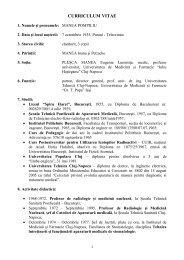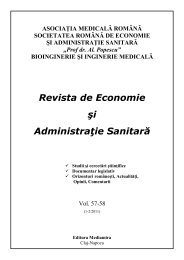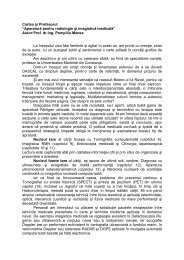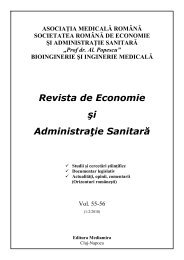Revista nr. 53-54 - Pompiliu Manea
Revista nr. 53-54 - Pompiliu Manea
Revista nr. 53-54 - Pompiliu Manea
- No tags were found...
You also want an ePaper? Increase the reach of your titles
YUMPU automatically turns print PDFs into web optimized ePapers that Google loves.
Accuracy in modeling and simulation of cardiovascular devices is ensured by thecomplexity of the models, which are usually multi-physics and multi-scale models, and by therealistic representation of the 3D structures representing organs and medical devices. In whatthe realism of the geometry of an object is concerned, its accurate measuring followed by thereconstruction as a 3D model plays a vital role. This process is known as reverse engineering(RE).Mechanical investigation of stent behavior in-vitro has included modeling andexperimental measurement of geometric changes during stent expansion [2] with someextension of this work to examine contact of the stent with the vessel and the resulting stressdistribution [3]. Other stent-related applications are still on the work-bench. One of the concernsabout carotid artery stenting (CAS) for example is the development of re-stenosis. Severalattempts have been made to overcome this drawback by using combinations of self-expandingand balloon expandable drug-eluting stents [4], [5]. Yet this surgical procedure still needsthorough experimental and numerical simulation investigations. For those numerical simulationto produce relevant results, realistic representation of the stent geometries and materialproperties is compulsory.In-vitro crushing tests are commonly used for assessing endovascular implants, thushelping manufacturers to improve the quality of their products [6], [7]. Even though the crushphenomenon is fairly rare in ISR, due to the protection conferred by the initial self-expandingstent [5], a finite element analysis (FEA) is however recommended and this is where thecontribution of a powerful resource like RE is welcome.Another potential application of RE for cardiovascular devices technology is theassessment of artificial heart valves (AHVs) performances. As AHVs are known to suffer fromthromboembolic complications, associated with local fluid dynamics, their potential impact onblood components, such as red blood cells (RBCS) or platelets, must be evaluated. Valvefunction is driven by interaction between the blood and the motion of solid valve structure. Inorder to examine such systems computationally it is necessary to consider both the solid andthe fluid phases simultaneously, requiring a fluid-structure interaction (FSI) analysis. To fullytaking advantage of the recent achievements in hardware and simulation software technology,realistic representations of the structural part of the model, i.e. the valve structure, has to beused. That is how RE intervene for brings these devices apart by analyzing their structure andworkings in detail, without copying anything from the original.Our paper presents several attempts of making use of two of the RE’s tools, X-Raymicrotomography and 3D laser scan, for getting a proper insight in the stents’ and AHVs’design.The X-Ray microtomography systemMETHODSAll our radiographic measurements have been attempted by using the X-Ray microtomographysystem (Fig. 1) from the National Institute for Lasers, Plasma and RadiationPhysics (NILPRP) [8].16







